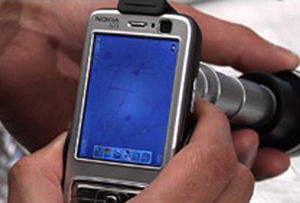
Problem being addressed
Malaria is a global health threat that threatens over 2 billion people worldwide. Low-cost, effective, and easy-to-use devices empower affected and at-risk communities with novel solutions to respond to malaria.
Detailed description of the solution[edit | edit source]
Light microscopy is one diagnostic method to address malaria. However, rural and developing regions may not have access to microscopy equipment or trained individuals to use the equipment to provide diagnostic feedback. CellScope is a technology that mounts a light microscope to cell phones. This system allows for images to be sent over a wireless network and provides a novel method to circumvent poorly funded and ill-equipped laboratories.
Designed by[edit | edit source]
- Design: CellScope was designed at the University of California- Berkeley by Professor Daniel Fletcher's group.
- Manufacturing: California, United States
When and where it was tested/implemented[edit | edit source]
Cellscope has been tested in Congo, Uganda, Kenya, and India, with upcoming studies planned in Vietnam.
Funding Source[edit | edit source]
- Bill and Melinda Gates Foundation
- Blum Center for Developing Economies (Link available here.)
- Microsoft Research (Link available here.)
- Center for Information Technology Research in the Interest of Society (CITRIS) (Link available here.)
- Intel (Link available here.)
- Vodafone Americas Foundation (Link available here.)
References[edit | edit source]
Peer-reviewed publication[edit | edit source]
Breslauer, D.N., Maamari, R.N. Switz, N.A., Lam. W.A., & Fletcher, D.A. (2009). Mobile phone based clinical microscopy for global health applications. PLos One, 4(7), e6320.
Externally generated reports[edit | edit source]
Doctor on call: Simple accessories could turn mobile phones into useful medical devices. (2007, May 17). The Economist, p. 103.
A microscope on your mobile: Cellscope (Best of what's new 2008: Health). (2008, Dec 20). Popular Science, 273(6), 63.
Howat, F. (1993, Feb.). Cellscope 2000 cellular system monitor. Cellular Business, 10(2), 64-66.